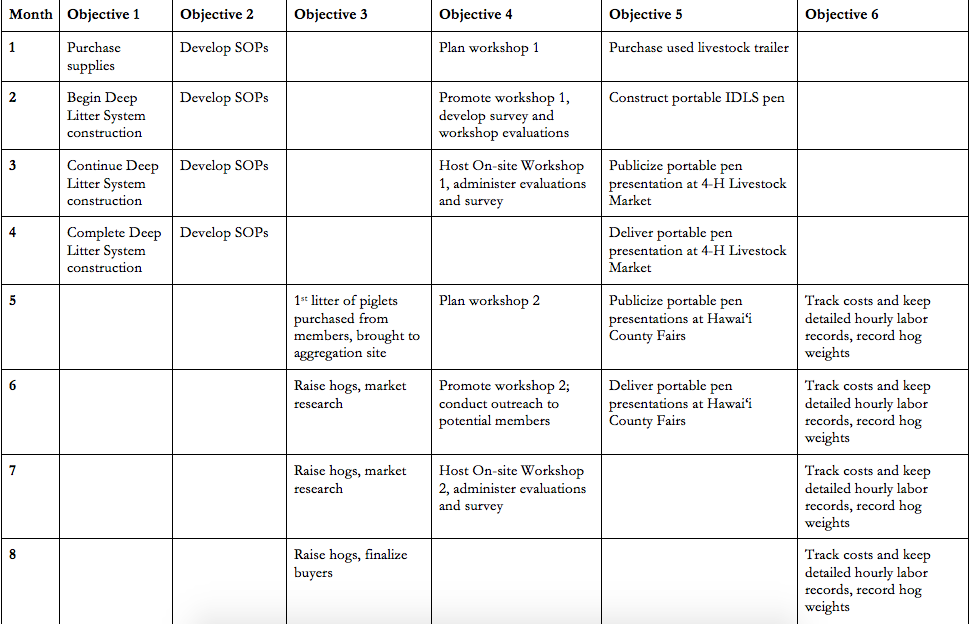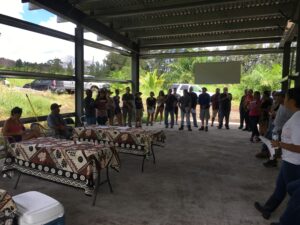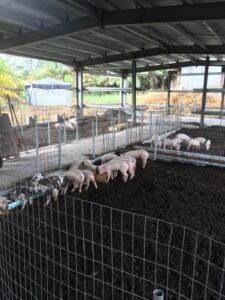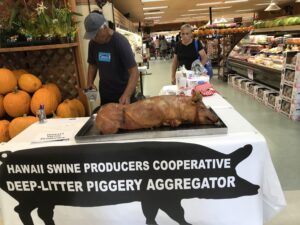Final report for FW19-339
Project Information
This project investigates the economic viability of a cooperative aggregation model for small-scale swine production in a tropical environment. Pork is a critical part of the culture in Hawai‘i for local consumers including Native Hawaiian, Filipino, Portuguese, Tongan, and Samoan communities. Many of these consumer groups prefer to buy whole pigs directly from local farms as pork cannot be purchased in this form from any other source in the state. Small piggeries often cannot meet demand or provide a consistent supply for consumers seeking farm-raised pork, whether it be for on-farm sales, marketplaces, restaurants, or value-added product ventures. Hawai‘i Swine Producers Cooperative (HSPC) aims to meet this demand by aggregating piglets from members, raising them to market weight, and selling them to local markets. In turn, this can increase the viability of small-scale local piggery operations by improving efficiency through economies of scale.
Hawai‘i Swine Producers Cooperative members operate piggeries using an innovative method called the Inoculated Deep Litter System (IDLS). IDLS utilizes green waste bedding and enhanced microbial activity for low-maintenance, low-odor pork production with reduced environmental impacts. During this project, the Cooperative aggregation site will host two workshops to educate local farmers about the benefits and methodology of IDLS, promoting adoption of the system and recruiting producers for HSPC membership and aggregator participation. HSPC members will also construct a portable IDLS pen and lead presentations at local agricultural events to demonstrate sustainable pork production methods and recruit new members.
Throughout the project, costs to establish and operate the aggregation site will be tracked, including supplies and detailed labor records. These financial records will be used to assess the economic feasibility of the cooperative aggregation model. This cost analysis can inform the establishment of future IDLS piggeries and swine aggregation sites in Hawai‘i and the Pacific Islands.
1: Construct deep litter system at swine aggregation center.
- Purchased supplies and mobile livestock trailer
- Installed litter layers
- Inoculated litter bedding
2: Develop and share standard operating procedures for the swine aggregation center.
- Wrote SOPs for aggregation center.
- Disseminate immediately the standard operating procedures.
3: Raise and sell first litter of 50 pigs.
- Receive 50 piglets from Hawai‘i Swine Producers Cooperative members
- Identify buyers
- Rear hogs to market weight, sell to buyers
- Record operational costs and revenue (including in-kind inputs and time)
4: Host 2 on-farm workshops on Inoculated Deep Litter System; showcase swine aggregation services.
- We hosted only one on-farm workshops because of the State wide lockdown due to the pandemic (Covid19). We designed a questionnaire to be administered before and after the workshop. The goal of the questionnaire was intended to measure knowledge, awareness and skills about sustainable agricultural change. The barriers to sustainability demonstrated through the workshop included a) the sequential steps in the design/creation of the inoculated deep litter system piggery. b) The impact of the IMO-spiked aerobic method on swine health and the environment. c) Identification of signs that the deep litter bed is working effectively. d) Pig care and feeding e) The new laws effecting waste management, food safety and conservation water, soil and air.
5: Construct and present Portable IDLS Pen to producers and the public at 3 local events.
We build the portable livestock pen and was able to present the portable IDLS pen to the public at only one local event. The presentation of the mobile livestock trailer in the International Food Day at our largest supermarket (KTA) generated significant interest about the multiple benefits of the deep litter system. Because of health concerns, local pigs buyer can't visit the aggravation site. Instead we used the portable IDLS Pen to deliver market size pigs to private buyers. AS a result we are receiving and continuing to receive orders for Fresh pork from the deep litter system piggery and inquiries for help to convert existing piggeries and assistance and direction to set- up the IDLS system.
6: Evaluate economic viability of cooperative aggregation and livestock-rearing center.
-
Economic profitability is a main driver of sustainability. The Hawaii Swine Producer Members all run their own piggeries to raise piglets. They are selling their wean-off piglets to the aggregation center which is raising them to market size. As co-owners of the Swine Cooperative, they receive the net profit of the revenue after deduction of feed and labor costs. This model addresses challenges of pig production such as feed, labor cost and marketing (in economic shutdown environment), improving the profitability for member farms and expanding opportunities for the new producer by eliminating barrier to entry. This in turn increases the viability of local small scale piggery operation by improving efficiency through economies of scale. A major consideration is that the IDLS requires a minimum start-up cost by eliminating the irrigation system and lagoon design and transportation of manure.


Cooperators
- - Producer
- - Producer
Research
Objective 1: Construct deep litter system at swine aggregation center.
In Month 1, the PI will purchase supplies for the deep litter system including cinder, hog wire, and mulch, feeders and watering system. Months 2-4 will be devoted to the construction of the deep litter system by laying down cinder, layers of cut logs and green waste, and inoculating the litter bedding with lactic acid bacteria and indigenous microorganisms. Feeders and watering systems will be installed. Once completed, the deep litter system will be prepared to support rearing the first 50 hogs.
Objective 2: Develop and share standard operating procedures for the swine aggregation center.
Technical advisor Dr. Zaleski will work with the PI with input from participating producers to develop Standard Operating Procedures (SOPs) for the aggregation facility. These SOPs will be revised after the first round of hogs are raised to reflect the operational challenges of maintaining the piggery facility. At the end of the project period, cost analysis information will be added to the revised SOPs and the final guide will be shared with academic outlets and agricultural communities through email, websites, and social media.
Objective 3: Raise and sell first 50 pigs.
In Month 5, the first 50 piglets will be delivered to the site by Cooperative members. In Months 5-9, these piglets will be raised to market weight. During this time, marketing research and outreach will identify buyers for these hogs and develop markets for future sales. By the end of Month 9, these hogs will be delivered to Kulana Foods in Hilo for slaughter and sold to buyers.
Objective 4: Host 2 on-farm workshops on Inoculated Deep Litter System; showcase swine aggregation services.
The Hawai‘i Swine Producers Cooperative members will plan and publicize two workshops in the local agricultural community. Members will conduct outreach at markets and other agricultural events to invite growers to the workshops and engage with prospective HSPC members. The workshops will be hosted by the new aggregation center in Months 7-8, showcasing IDLS methods and the facility’s services.
Objective 5: Construct and present Portable IDLS Pen to producers and the public at local agricultural and community events.
Project producers will construct a portable IDLS pen to serve as a mobile educational tool for the Hawai‘i Island community. The Hawai‘i Swine Producers Cooperative members will plan, publicize, and lead 3 presentations of the portable pen at the following Hawai‘i Island events: West Hawai‘i County Fair, East Hawai‘i County Fair and the 4H Livestock Farmers Market. Presentations will serve to educate the public and local farmers about the benefits and methodology of IDLS, promote adoption of the system, and encourage future deep litter piggeries and swine aggregation sites in Hawai‘i and the Pacific Islands.
Objective 6: Evaluate economic viability of cooperative aggregation and livestock-rearing center.
The project team will estimate total expenses for the construction of the deep litter system and rearing the first 50 pigs by reviewing actual costs and hourly labor requirements. A value will be assigned to labor by the hour (equal to or greater than minimum wage in Hawai‘i, $10.10). After market research has identified potential buyers and the first litter of hogs is sold, revenue from sales will be included in the cost analysis. The team will then work with Judi Mellon of the Small Business Development Center to evaluate the business model for the cooperative aggregation center and determine potential for profitability at various scales of production up to 1000 head of swine. This information can then be used to set recruitment and production targets for the Hawai‘i Swine Producers Cooperative in order to ensure the viability of the operation.
Economic profitability is a main driver of sustainability. The Hawaii Swine Producer Members all run their own piggeries to raise piglets. They are selling their wean-off piglets to the aggregation center which is raising them to market size. As co-owners of the Swine Cooperative, they receive the net profit of the revenue after deduction of feed and labor costs. As result this model addresses challenges of pig production such as feed and labor cost, improving the profitability for member farms and expanding opportunities for the new producer by eliminating barrier to entry. This in turn increases the viability of local small scale piggery operation by improving efficiency through economies of scale.
Compare to the conventional system used previously (washed down system) a major consideration is that the IDLS requires a minimum start-up cost by eliminating the irrigation system and lagoon design and transportation of manure; reduces the risk of surface, ground and coastal water contaminations and requires less water to operate.
Research outcomes
Education and Outreach
Participation summary:
We conducted a workshop and designed a questionnaire to be administered before and after the workshop. The goal of the questionnaire was intended to measure knowledge, awareness and skills about sustainable agricultural change. The barriers to sustainability demonstrated through a workshop included a) the sequential steps in the design/creation of the inoculated deep litter system piggery. b) the impact of the IMO-spiked aerobic method on swine health and the environment; c) identification of signs that the deep litter bedding is working effectively; d) pig care and feeding; e) the new laws effecting waste management, food safety and conservation water, soil and water.
Pre and Post survey analysis of participants. Seventy-one responses were recorded on a likert-like scale. The numbers are means based on the following scale: Questions were drawn from the Fact Sheet.
5 4 3 2 1
Strongly Agree Agree Neutral Disagree Strongly Disagree
Pretest. Posttest
1. I know the building material requirements for an IDLS. 2.14. 4.90
- I know the longest length is oriented north-south. 1.76 4.97
- I know the air circulation requirement for heat and sun. 2.10 4.79
- I know how to define inoculant. 1.86. 4.91
- I know how to make the inoculant. 1.52 4.90
- I know how and when to apply the inoculant. 2.10 4.90
- I know how the IDLS benefits swine health. 2.00. 4.83
- I understand how the IDLS benefits the environment. 1.48 4.62
- I understand how the IDLS benefits the farmer. 1.43 4.66
- I understand my IDLS is effective: No fly, No smell. 2.05 4.36
- I understand my IDLS is effective if it is aerobic. 1.95 4.34
- I know how to host a big microbial community. 1.10 4.55
- I know my IDLS is organic and requires no cleaning. 1.00 4.90
On all 13 items post survey responses significantly differ from pre survey responses. Participants began this project with a limited knowledge of how to sequentially develop a successful inoculated deep litter piggery. Approximately 50% reported no knowledge about how to construct the IDLS. Seventy-six percent reported no knowledge on creating and implementing the inoculants. Sixty-seven percent reported not knowing the benefits of the IDLS to the pig, the farmer and the environment. Sixty-seven percent reported not knowing how to identify if their IDLS was effective. Fifty-two percent reported limited knowledge in how to develop the organic matter to host a thriving microbial community to digest the pig waste.
After participating in our Hands-On Workshop, one hundred percent of the participants report that they feel confident that they can successfully set up their own IDLS, prepare and implement the inoculants and generate a rich microbial community to digest the pig waste. The participants became enthusiastic about the low maintenance and environmentally friendly system for their pigs and chickens. All members were looking forward to the production and contribution to the community that will evolve from their eco-friendly IDLS piggeries.

The Hawaii Swine Producer Members all run their own piggeries to raise piglets. They are selling their wean-off piglets (50 piglets) to the aggregation center which is raising them to market size. As co-owners of the Swine Cooperative, they receive the net profit of the revenue after deduction of feed and labor costs. This model addresses challenges of pig production such as feed and labor cost, improving the profitability for member farms and expanding opportunities for the new producer by eliminating barrier to entry. This in turn increases the viability of local small scale piggery operation by improving efficiency through economies of scale. A major consideration is that the IDLS requires a minimum start-up cost by eliminating the irrigation system and lagoon design and transportation of manure.

By far, the key success of this project was the presentation of the mobile livestock trailer.
This performance generated significant interest about the multiple benefits of the deep litter system. Another highly successful project was our participation in the International Food Day at our largest supermarket (KTA super store). The visiting consumers (87) relished the opportunity to taste fresh roasted pork from the cooperative aggregation center. The roasted pork received rave notices. As a result we are receiving and continuing to receive orders for Fresh pork from the deep litter system piggery, and inquiries for help to set up an IDLS piggery or to convert existing washed down piggeries to the IDLS system.

Education and Outreach Outcomes
Best waste management swine system: Specifically they are learning about the direct benefits of the IDLS system to the swine and the farmer. The major environmental boosts that this system provides i.e., the reduced risk of ground and surface water contamination is their first and most salient observation. The most robust and much discussed is the low-odor ambience of the piggery and zero odor in the surrounding acreage.
Social impact: Participating farmers are also now aware of the salient change in attitudes across the population of the neighbors as well as the public; from social ostracism to viewing and accepting pigs as good neighbors.
Improved rural life: participants understand the benefits associated with improved health and comfort for the livestock, the minimization of the workload for the farmer and positive impact to the health and safety for the farmer, his family and the environment. Our participating farmers no longer consider swine farming to pose a public health hazard.